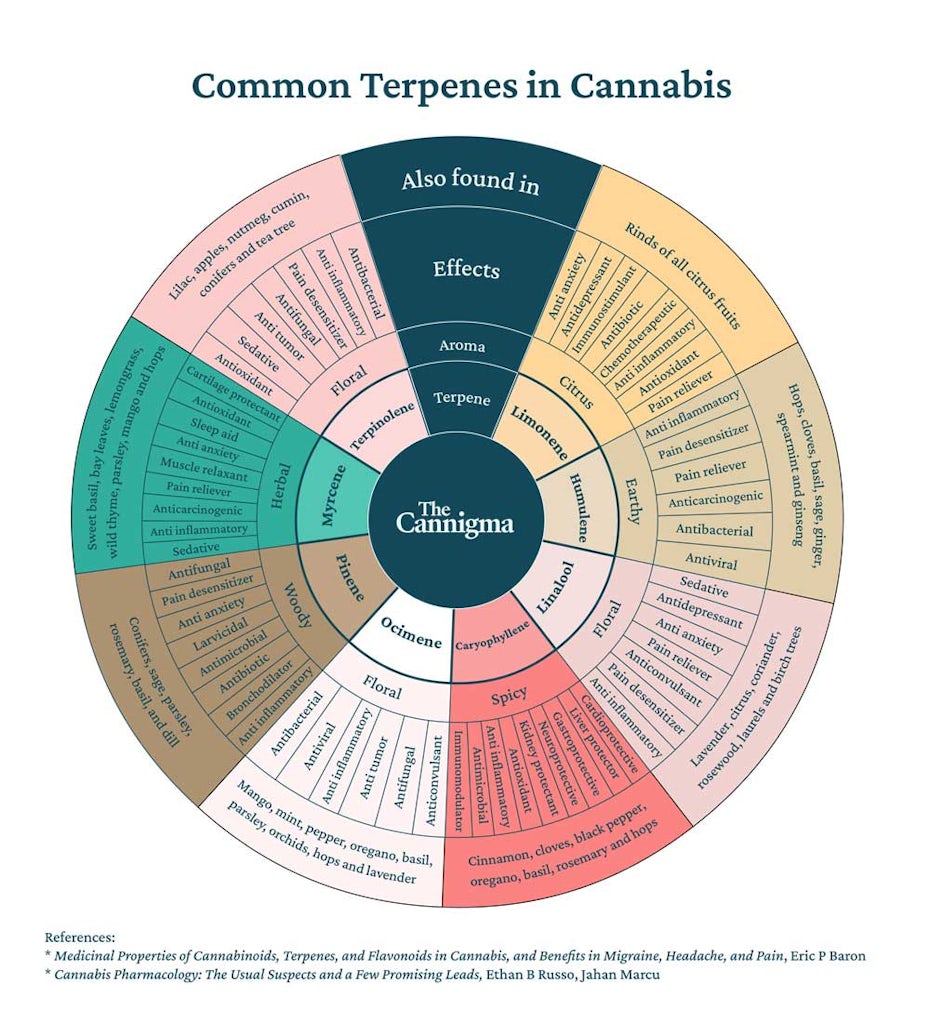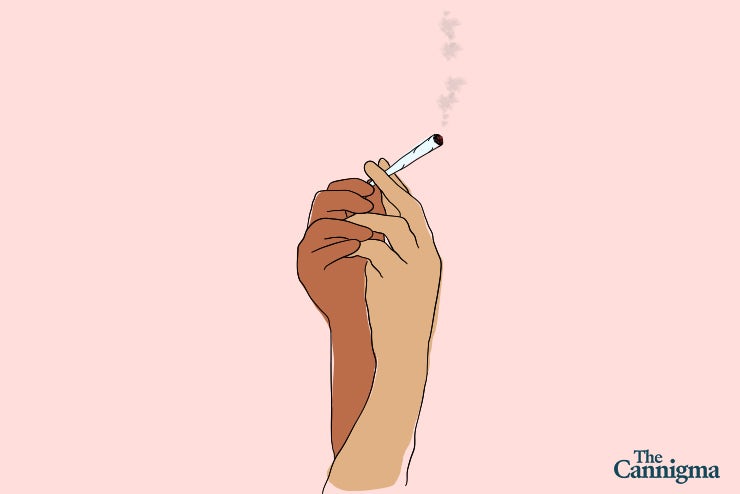Have you ever had a mind-blowingly good idea while you were high?
More than half of cannabis users report the plant increases their creativity. They say cannabis can lower inhibition and self-judgment while allowing you to connect with yourself and a new way of looking at things. But does the science back this up?
Whether or not cannabis impacts creativity is a challenging thing to measure. Cannabis research is only just opening up and studies on creativity are few and far between. We also don’t know which, if any, terpenes have an effect on creativity. That being said, there are conclusions we can draw based on existing research. So if you’re consuming cannabis to get your creative brain firing, what strains should you reach for?
The best strains for creativity are Type II, with a balance of THC and CBD and a terpene profile that includes pinene, linalool, and beta-caryophyllene.
Strains mentioned in this article include:
How cannabis can boost creativity
While anecdotal evidence may lead you to believe cannabis is a miracle drug for artistic creation, the science is less straightforward (as is often the case).
Scientists are divided on what cannabis can do for creativity. Some scientists believe there is a “plateau of creativity” and cannabis can’t change your ability to think about situations differently. Others believe that cannabis may be able to help some people get “in the zone” while having the opposite effect on others.
According to a 2018 study, artists use cannabis to balance the extreme emotional states present during their creative process, and the impact of drug use on creativity was unique to each artist. On the other hand, a 2015 study found that large doses of THC can actually make you less creative. Furthermore, some scientists have theorized that cannabis may help create original ideas, and indeed researchers in a 2021 study found this to be the case, but they also found that the weed smoker’s ideas were less feasible compared to non-consumers. 1 2 3
There’s also the chicken and the egg question – does cannabis make you more creative, or are creative people more likely to use cannabis in the first place? A 2012 study found that people with naturally low creativity experienced boosted creativity when they consumed cannabis – at least when looking at divergent thinking and verbal fluency. Another study from 2009 found that cannabis users had more “rare-creative” responses than a control group, even if they didn’t rate themselves as more creative in a self-report. 4 5
So if cannabis does improve creativity for some people, how?
A side effect of cannabis consumption is increased blood flow, particularly in the brain. A 2002 study found that smoking cannabis increased blood flow in the frontal lobe, an area that’s thought to play an important role in abstract thought, creative thinking and sensory processing. Little wonder that boosting blood flow to this area of the brain can leave some people with wild high thoughts and highdeas. 6 7
But the frontal lobe isn’t the only area of the brain that’s affected. Consuming THC increases blood flow to the cingulate cortex, which regulates sensory information and emotion. 8 CBD also increases blood flow to certain areas, particularly those involved in memory processing. 9
In short, cannabis changes, and can increase, blood flow to certain areas of the brain, particularly those concerned with thought processes and decision making, so it makes sense that your perspective would change. Of course, this is just one of many theories on how cannabis may change our thinking. It has also been found that cannabis users in general are more open to new ideas or experiences, and may also have higher levels of creativity than non users, even when sober. 10
Being more creative is an abstract measure, so what should you look for? While it’s hard to say “look for a strain that increases creative thinking” you should look for strains that:
- Have a balance of THC and CBD
- Increase focus
- Are energizing
- Reduce stress
How to choose cannabis for creativity
While the standard method of choosing cannabis strains is to look at the indica/ sativa divide, this is actually a poor method of determining how a strain will affect you. Indica and sativa are plant names that refer to the physical differences between the plant, not the chemical compound within the nugs. Strain names aren’t much help either, since there are no standardized regulations.
Instead, look to the plant chemovar as your first clue for how a strain will affect you. There are three primary types of cannabis chemotypes (for now.)
- Type I – High THC. Low CBD
- Type II – balanced THC and CBD
- Type III – High CBD, low THC
Type II is the best type to reach for to boost creativity, as it balances the stimulating effects of THC with the calming or mitigating effects of CBD, letting you open your mind without floating away and getting distracted. Type II strains can be challenging to find, so another alternative is blending in some CBD with your Type I products.
While Type I is the most common chemotype on the market, it’s not necessarily the most effective for increasing your creativity. Type I cannabis’ high concentration of THC can increase anxiety or drowsiness in some people, which isn’t conducive for artistic creation. However, THC has biphasic effects, which means different doses can produce different reactions.
How and where you consume cannabis matter too. Smoking cannabis produces significantly higher blood levels of THC compared to edibles, which have lower peak THC levels but produce higher levels of the psychoactive THC metabolite 11-hydroxy-THC. How these differences affect creativity is a question not yet explored in the scientific literature. 11 12
As an aside, being in an environment conducive to relaxing while a mindset primed towards creation is a big factor in your creative abilities, with or without cannabis.
Best terpenes for creativity
- Pinene
- A 2005 study of terpenes found that pinene acts as an inhibitor of acetylcholinesterase, an enzyme that breaks down the important neurotransmitter acetylcholine, which may help to enhance energizing and focus effects. 13
- A 2018 study tested the effects of alpha and beta pinene on men and women by measuring their brain waves with an EEG test. They found that while men and women both responded to alpha-pinene while women reacted more strongly than men to beta-pinene. 14
- Linalool
- Beta-Caryophyllene (BCP)
- Beta-caryophyllene has a dose-dependent anti-anxiety effect and can act as a central nervous system depressant, which slows down brain activity. 18 While this may not sound ideal for creativity, a calm mind can focus better and dive deeper into ideas, rather than bouncing around.
- BCP also has numerous properties, including the ability to activate the CB2 receptor of the endocannabinoid system, mediating inflammation and altering immune response. 19
- Eucalyptol (a.k.a. 1,8–cineole)
- A 2020 study on nursing home residents found that inhaled eucalyptol increases blood flow throughout the brain and stimulates the frontal cortex. 20

Of course, accessing the terpene profile of your weed can be as big of a challenge as finding Type II cannabis. Some terpenes, like eucalyptol, are beneficial for creativity, but aren’t present in cannabis plants in high quantities. You can always substitute or supplement your cannabis routine with essential oils to gain the beneficial effects. Tea tree oil and eucalyptus oil may both contain high levels of eucalyptol.
Best strains for creativity
The best strains to improve creativity have a balance of CBD and THC with a terpene profile that includes beta-caryophyllene, linalool, and pinene. Strains with this profile include ACDC and Cannatonic, but these are just a couple examples. Instead of looking for these varieties, you should ask to see the certificate of analysis when possible. If you don’t have access to lab reports, the next best thing is to use the tool mother nature provided – your nose.
The internet’s favorite strains for creativity
A quick search on the internet will give you an extensive list of recommended strains to boost your creativity. Although these strains don’t meet the Type II qualifications, if you are accustomed to high-THC cannabis varieties, you may consider linalool or beta-caryophyllene rich varieties like Cinderella 99 or G-13 to get you outside of your normal thinking.
Sources
- Iszaj F, Ehmann B, Griffiths MD, Demetrovics Z. A Qualitative Study on the Effects of Psychoactive Substance use upon Artistic Creativity. Subst Use Misuse. 2018;53(8):1275-1280. doi:10.1080/10826084.2017.1404103
- Kowal MA, Hazekamp A, Colzato LS, van Steenbergen H, van der Wee NJ, Durieux J, Manai M, Hommel B. Cannabis and creativity: highly potent cannabis impairs divergent thinking in regular cannabis users. Psychopharmacology (Berl). 2015 Mar;232(6):1123-34. doi: 10.1007/s00213-014-3749-1. Epub 2014 Oct 7. PMID: 25288512; PMCID: PMC4336648.
- Warnick, Benjamin & Kier, Alex & LaFrance, Emily & Cuttler, Carrie. (2021). Head in the clouds? Cannabis users’ creativity in new venture ideation depends on their entrepreneurial passion and experience. Journal of Business Venturing. 36. 106088. 10.1016/j.jbusvent.2020.106088.
- Schafer G, Feilding A, Morgan CJ, Agathangelou M, Freeman TP, Valerie Curran H. Investigating the interaction between schizotypy, divergent thinking and cannabis use. Conscious Cogn. 2012 Mar;21(1):292-8. doi: 10.1016/j.concog.2011.11.009. Epub 2012 Jan 9. PMID: 22230356; PMCID: PMC3657189.
- Jones KA, Blagrove M, Parrott AC. Cannabis and Ecstasy/ MDMA: empirical measures of creativity in recreational users. J Psychoactive Drugs. 2009 Dec;41(4):323-9. doi: 10.1080/02791072.2009.10399769. PMID: 20235438.
- Roger G. Pertwee,Pharmacology of cannabinoid CB1 and CB2 receptors, Pharmacology & Therapeutics,Volume 74, Issue 2, 1997,Pages 129-180,ISSN 0163-7258,https://doi.org/10.1016/S0163-7258(97)82001-3.
- de Souza Leonardo C., et all. Frontal lobe neurology and the creative mind. Frontiers in Psychology V5 2014 https://www.frontiersin.org/article/10.3389/fpsyg.2014.00761, DOI 10.3389/fpsyg.2014.00761
- Vogt, B. Pain and emotion interactions in subregions of the cingulate gyrus. Nat Rev Neurosci 6, 533–544 (2005). https://doi.org/10.1038/nrn1704
- Bloomfield MAP, Green SF, Hindocha C, Yamamori Y, Yim JLL, Jones APM, Walker HR, Tokarczuk P, Statton B, Howes OD, Curran HV, Freeman TP. The effects of acute cannabidiol on cerebral blood flow and its relationship to memory: An arterial spin labelling magnetic resonance imaging study. J Psychopharmacol. 2020 Sep;34(9):981-989. doi: 10.1177/0269881120936419. Epub 2020 Aug 7. PMID: 32762272; PMCID: PMC7436497.
- LaFrance EM, Cuttler C. Inspired by Mary Jane? Mechanisms underlying enhanced creativity in cannabis users. Conscious Cogn. 2017;56:68-76. doi:10.1016/j.concog.2017.10.009
- Spindle TR, Martin EL, Grabenauer M, Woodward T, Milburn MA, Vandrey R. Assessment of cognitive and psychomotor impairment, subjective effects, and blood THC concentrations following acute administration of oral and vaporized cannabis. J Psychopharmacol. 2021;35(7):786-803. doi:10.1177/02698811211021583
- Lucas CJ, Galettis P, Schneider J. The pharmacokinetics and the pharmacodynamics of cannabinoids. Br J Clin Pharmacol. 2018;84(11):2477-2482. doi:10.1111/bcp.13710
- Miyazawa M, Yamafuji C. Inhibition of acetylcholinesterase activity by bicyclic monoterpenoids. J Agric Food Chem. 2005 Mar 9;53(5):1765-8. doi: 10.1021/jf040019b. PMID: 15740071.
- Minju Kim, Kandhasamy Sowndhararajan, Se Jin Park, Songmun Kim, Effect of inhalation of isomers, (+)-α-pinene and (+)-β-pinene on human electroencephalographic activity according to gender difference, European Journal of Integrative Medicine, Volume 17, 2018, https://doi.org/10.1016/j.eujim.2017.11.005.
- Weston-Green Katrina, Clunas Helen, Jimenez Naranjo Carlos, A Review of the Potential Use of Pinene and Linalool as Terpene-Based Medicines for Brain Health: Discovering Novel Therapeutics in the Flavours and Fragrances of Cannabis Frontiers in Psychiatry, V12, 2021. https://www.frontiersin.org/article/10.3389/fpsyt.2021.583211. DOI 10.3389/fpsyt.2021.583211
- Moss M, Hewitt S, Moss L, Wesnes K. Modulation of cognitive performance and mood by aromas of peppermint and ylang-ylang. Int J Neurosci. 2008 Jan;118(1):59-77. doi: 10.1080/00207450601042094. PMID: 18041606.
- Araos, Danielle, A Heuristic Study on the Effects of Art Therapy and Essential Oil Diffuser for Treating Academic Stress and Test Anxiety 2019
- Rufino AT, Ribeiro M, Judas F, Salgueiro L, Lopes MC, Cavaleiro C, Mendes AF. Anti-inflammatory and chondroprotective activity of (+)-α-pinene: structural and enantiomeric selectivity. J Nat Prod. 2014 Feb 28;77(2):264-9. doi: 10.1021/np400828x. Epub 2014 Jan 23. PMID: 24455984.
- Francomano F, Caruso A, Barbarossa A, Fazio A, La Torre C, Ceramella J, Mallamaci R, Saturnino C, Iacopetta D, Sinicropi MS. β-Caryophyllene: A Sesquiterpene with Countless Biological Properties. Applied Sciences. 2019; 9(24):5420. https://doi.org/10.3390/app9245420
- Goto, S., Suzuki, H., Nakagawa, T. et al. The Effect of Eucalyptol on Nursing Home Residents. Sci Rep 10, 3996 (2020). https://doi.org/10.1038/s41598-020-61045-8
Sign up for bi-weekly updates, packed full of cannabis education, recipes, and tips. Your inbox will love it.

 Shop
Shop Support
Support
















